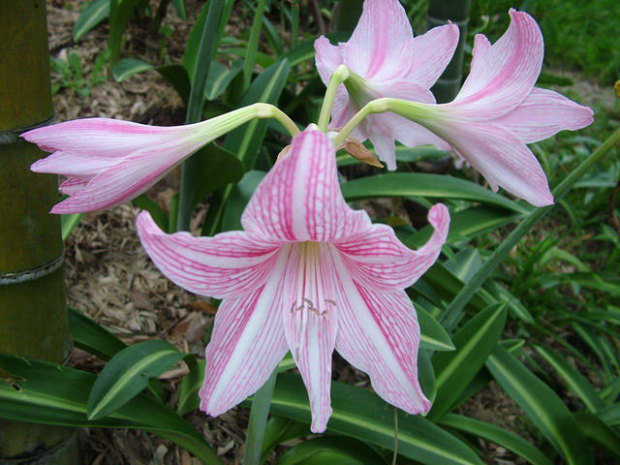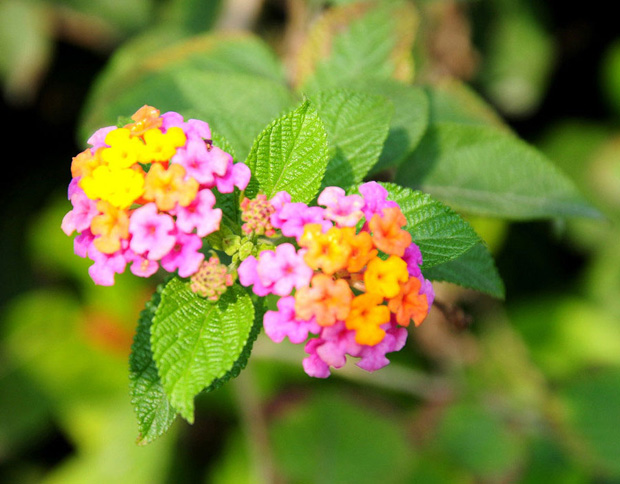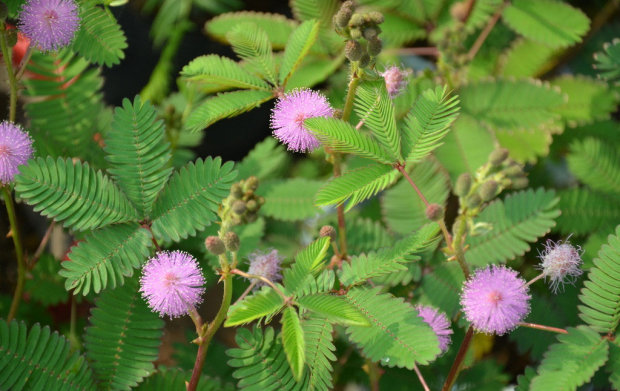Cultivation and Culture methods of Zhu Dinghong
On Zhu Dinghong's large, globular bulb, there are 8 flattened and slightly fleshy leaves, which are drawn out at the same time or after flowering, and there are stout and hollow flower stems in the leaves, which are similar to lilies, while there are 6 bright funnel-shaped flowers in white, red, or white and red varieties. Zhu Dinghong is native to Peru; likes warm, moist, semi-shady or less sunny environment; is not hardy; grows best in sandy loam with high humus and good drainage. There are more indoor potted flowers in North China, and occasionally they can be cultivated in the courtyard in spring. East China should be protected to survive the winter, while South China can be planted all the year round.

The method of sowing or separating bulbs is used for reproduction. After the seeds are ripe, they can be sown. In the case of 18 Mel 20 degrees, it will sprout in about 10 days; when transplanting seedlings, pay attention to prevent root injury, sowing seedlings should be given adequate nutrition and meticulous management, and blossom in the third year. Generally, the bulblets are propagated by the method of separating the bulbs, and the bulbs born around the mother ball are separated, cultured and flowered the following year. This method is often used in families. Potted Zhu Dinghong should choose large and full bulbs, planted in 18mur20cm pot, potted in April, can blossom in June, potted in September, placed in a warm room, and can blossom in March or April of the following spring. It is most suitable to use fertile loam rich in humus and fine sand as potted soil. The bottom of the basin should be covered with rotten base fertilizer and paved gravel to facilitate drainage. When planting bulbs, the top should be slightly exposed to the soil, and the potted plants should be placed in a semi-shady place to avoid direct sunlight in summer. During the period of growth and flowering, it is appropriate to apply 2Mel topdressing mainly with phosphorus and potassium fertilizer for 3 times, which can make the plant strong, the leaves thick green, the flowers many and colorful. When the bulb enters the dormant period, the watering child should be reduced to keep the bulb from withering, and place it in a cool and dry place; if it is watered too much and the temperature is too low, the stems and leaves will grow too long. The cultivation and cultivation method of Zhu Dinghong on Zhu Dinghong's large and round bulb, there are 8 flattened and slightly fleshy leaves, which are drawn out at the same time or after flowering, and there are stout and hollow flower stems in the leaves, which are similar to lilies, while there are 6 bright funnel-shaped flowers in white, red, or white and red varieties. Zhu Dinghong is native to Peru; likes warm, moist, semi-shady or less sunny environment; is not hardy; grows best in sandy loam with high humus and good drainage. There are more indoor potted flowers in North China, and occasionally they can be cultivated in the courtyard in spring. East China should be protected to survive the winter, while South China can be planted all the year round. The method of sowing or separating bulbs is used for reproduction. After the seeds are ripe, they can be sown. In the case of 18 Mel 20 degrees, it will sprout in about 10 days; when transplanting seedlings, pay attention to prevent root injury, sowing seedlings should be given adequate nutrition and meticulous management, and blossom in the third year. Generally, the bulblets are propagated by the method of separating the bulbs, and the bulbs born around the mother ball are separated, cultured and flowered the following year. This method is often used in families. Potted Zhu Dinghong should choose large and full bulbs, planted in 18mur20cm pot, potted in April, can blossom in June, potted in September, placed in a warm room, and can blossom in March or April of the following spring. It is most suitable to use fertile loam rich in humus and fine sand as potted soil. The bottom of the basin should be covered with rotten base fertilizer and paved gravel to facilitate drainage. When planting bulbs, the top should be slightly exposed to the soil, and the potted plants should be placed in a semi-shady place to avoid direct sunlight in summer. During the period of growth and flowering, it is appropriate to apply 2Mel topdressing mainly with phosphorus and potassium fertilizer for 3 times, which can make the plant strong, the leaves thick green, the flowers many and colorful. When the bulb enters the dormant period, the watering child should be reduced to keep the bulb from withering, and place it in a cool and dry place; if it is watered too much and the temperature is too low, the stems and leaves will grow too long. Hinder dormancy and affect normal flowering. The ground should be planted as a spring planting bulb, and the cultivated land should choose a site with good drainage. From May to June, dig out the bulb in early October, slightly dry the bulb skin, and bury it in plain sand at a temperature of 10-13 degrees for planting in the following year. There are reddish-red disease spots on stems, leaves and bulbs during cultivation, which should be prevented by soaking in 40-44 degrees warm water for 1 hour during the dormant period. Zhu Dinghong wide band-shaped leaves, fresh green clean, chic posture; umbels have large colorful flowers better than gentleman orchids; whether potted or planted on the ground are unusually beautiful; its flower stems are tall and straight, and suitable for cut flowers. [Zhu Dinghong] Culture method and picture appreciation of Zhu Dinghong
The common varieties of Zhu Dinghong are Red Lion, Hercules, Lilona, Flower Crown, Soviliqin, Goddess of Wisdom and other varieties, and the flowers are mostly crimson or orange. Mainly like the warm and humid climate, the suitable temperature for growth is 18-25 degrees Celsius, avoid cool sun, pay attention to the sun when breeding. Zhu Dinghong's culture method needs to pay special attention to temperature and light in culture. Zhu Dinghong is not cold-resistant and does not like high temperature, so we should pay attention to the observation of temperature changes in culture. The temperature should not be less than 5 degrees Celsius. Maintain humidity but pay attention to avoid direct sunlight, otherwise it will harm the plants.
The growth of Zhu Dinghong has no special requirements on the soil, what is needed is a more fertile and loose soil, and the sandy soil with good drainage can be chosen, because it is mostly dormant in winter, so we need to pay attention to that the soil in the red flowerpot after autumn can be kept dry as far as possible, but not too dry will cause the rhizome to wither.
Zhu Dinghong grows very fast, because in its exuberant growing season, attention should be paid to changing pots and soil. Generally, Zhu Dinghong should change flowerpots after growing for one year. In order to promote the blooming of the new year, Zhu Dinghong can change soil for Zhu Dinghong in the spring after two years of breeding. The problem with the rapid growth of Zhu Dinghong is that there will be a lot of bulbs growing out when it has been growing for about 2 years, and then it can be ramified when changing pots.
Zhu Dinghong's fertilization and pruning, Zhu Dinghong likes fertile soil. She can irrigate phosphorus and potassium fertilizer appropriately once a month, or fertilize at the bottom of the flowerpot when changing pots. The main principle of fertilization is a small number of times to promote the growth and flowering of Zhu Dinghong. Pruning Zhu Dinghong should be carried out at the same time when changing pots and soil. The main purpose of pruning Zhu Dinghong is to remove fallen leaves, withered roots and places with insect pests, leaving exuberant leaves.
When Zhu Dinghong is dormant, it should be noted that watering should be strictly controlled, that is, there is water to keep it from withering; close air temperature, generally there is no resistance when plants are dormant, so it is necessary to keep the indoor temperature between 10 degrees Celsius at this time; for newborn bulbs, they can be buried in the sand. Zhu Dinghong's dormancy can end around January, when the flowers can be watered thoroughly to awaken dormancy.
For the cultivation of flowers, we need to take careful care of and observe their changes. The cultivation of Zhu Dinghong needs to pay close attention to the temperature and light, because these two have an important impact on its growth.
- Prev

Cultivation and Culture methods of Prunus mume
Because the five-colored plum blossoms successively and in different colors, some people call it Qiqiuhua, and it is called Lantana in Guangzhou. It is an evergreen shrub of Verbenaceae, with coarse hairs and fine thorns in the whole plant, rough thorns in the hands and a strong smell. Inflorescences densely formed by most florets
- Next

Cultivation and culture methods of mimosa
Mimosa is also called fear of ugliness and mimosa. It is one of the plants that people are most interested in. Its leaves are very sensitive to stimuli, people touch the small leaves with their fingers and immediately close them shyly, then the whole leaves hang down again, and after a while, the leaves gradually return to their original state. The special ability of mimosa
Related
- Fuxing push coffee new agricultural production and marketing class: lack of small-scale processing plants
- Jujube rice field leisure farm deep ploughing Yilan for five years to create a space for organic food and play
- Nongyu Farm-A trial of organic papaya for brave women with advanced technology
- Four points for attention in the prevention and control of diseases and insect pests of edible fungi
- How to add nutrient solution to Edible Fungi
- Is there any good way to control edible fungus mites?
- Open Inoculation Technology of Edible Fungi
- Is there any clever way to use fertilizer for edible fungus in winter?
- What agents are used to kill the pathogens of edible fungi in the mushroom shed?
- Rapid drying of Edible Fungi

